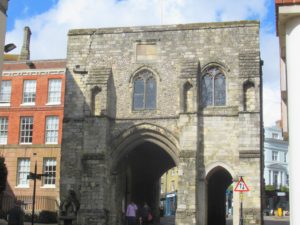You cannot visit Winchester without being aware of King Alfred, from the imposing 17-foot statue at the eastern end of the High Street to the various plaques situated around the town citing his name. In 871 at the age of 21, Alfred was crowned King of Wessex and established Winchester as his capital.
A Tourist Information “leaflet”:https://www.visitwinchester.co.uk/app/uploads/2018/05/City-Walk-web.pdf showed three walks which would allow us to follow in his footsteps on an historic tour:
The heart of the ancient capital – 1 mile allow an hour and suitable for wheelchair users
The upper city – 1 mile allow an hour, unsuitable for wheelchair users as there are some steep sections and steps
Alfred’s final journey – 1 mile allow an hour and suitable for wheelchair users
The first walk started near our hotel, the Mercure Winchester Wessex, and took us down the pedestrianised High Street, past the refurbished Guildhall and on to King Alfred’s statue before we headed onto a path alongside an incredibly fast flowing River Itchen. It was a lovely walk, but we turned off after a short while and headed past Wolvesey Castle, Winchester College and the house where Jane Austen died. Passing through Priors Gate we found the Medieval Cheyne Court before walking around the cathedral, which we decided to save for another day, before finding ourselves back onto the High Street and a small alley where we spied a number of independent eateries.
The second walk took us up the High Street in the opposite direction towards the train station and passed the Butter Cross and onto the Westgate with its impressive arch. Having walked up a main road we came to the Hampshire Jubilee Sculpture outside the Crown Court, the remains of the original fortress and a flagstone commemorating the Magna Carta. We then entered an area containing all the Military Museums and the parade ground with its lovely fountain, pond and immaculately trimmed conifer trees. We got a little lost here, but eventually found the steps which led back down with the spire of St Thomas Church guiding us. Interestingly this church had an estate agent’s for sale sign in the grounds.
The third walk, Alfred’s Final Journey, took us the furthest out of town. We passed St Peter’s Roman Catholic Church, built as recently as 1926, but despite walking around it, failed to locate the Norman doorway salvaged from St Mary Magdalen Leper Hospital. We continued along residential streets, past the Theatre Royal and Winchester Discovery Centre (formerly the Corn Exchange) and up to king Alfred Place. Our first stop was St Bartholomew’s churchyard where we once again failed to find the stone slab incised with a cross where the bones originally thought to be King Alfred’s were reburied. We weren’t doing well. Hyde Gate, the former entrance to Hyde Abbey, was an impressive gothic arch and inside along with the pigeon droppings were information boards setting out the history. Continuing along King Alfred Place we came to Hyde Abbey Garden, said to reflect the Abbey church, and which marks the site of Alfred the Great’s medieval tomb. What caught our eye the most was around half a dozen holly bushes encased in a type of metal frame – it was not clear what purpose they served. We crossed the River Itchen and then retraced our steps back into town. This was the least interesting of the three walks, but it took us an hour and allowed us to stretch our legs over around 5,000 steps on what was a chilly but sunny morning.
All three walks were a great introduction to the city, in terms of history and orientation.










